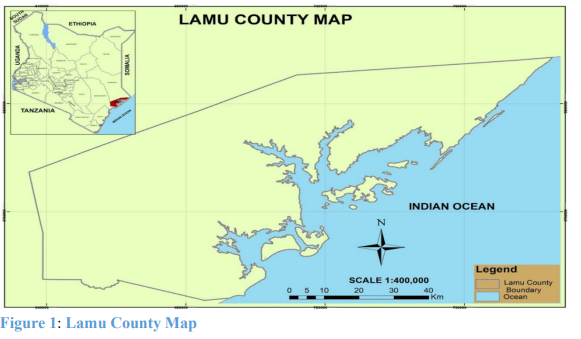Lamu County, located on Kenya’s North coast, spans 6,607 km2 and is part of the coastal region. It comprises a mainland and 65 islands, including Lamu, Manda, Pate, Kiwayu, and Ndau. The county has a 130 km coastline and is known for its rich biodiversity and unique ecosystem. The Lamu Archipelago is a significant world ecological and cultural heritage, with 75% of Kenya’s mangrove forests located there. The area has diverse coral reefs, sea-grass beds, sand bars, lagoons, and creeks, supporting a lucrative fishing industry. Lamu was one of the earliest seaports in East Africa, attracting traders from Portugal, India, China, Turkey, and the Middle East. The county is recognized as a UNESCO world heritage city. Arts play a crucial role in preserving Lamu society’s cultural fabric, from woodcarving to poetry.

Administrative Units
Lamu county is composed of two constituencies comprising the Lamu East and Lamu West.The county is also made of seven divisions, 23 locations and 38 sub locations.
Population size and composition
Lamu County is the least populated county in Kenya. with a population of 143,000 people. Table 4 contains population data sourced from the Kenya National Population and Housing Census Report 2019, as the base year, the current estimates, and projections for both mid (2025) and end (2027) of the plan period, segregated by sex. Lamu west sub county is the highest populated sub-county followed by Lamu East.
In terms of healthcare infrastructure, Lamu County has a total of 45 health facilities, including one county referral hospital. These facilities are distributed across various regions to serve the local population. To enhance healthcare accessibility, the County Government has been constructing, equipping, and operationalizing new dispensaries and health centers, particularly in hard-to-reach areas and new settlements. Notably, the newly built Wiyoni and Kashmir dispensaries in Mkomani Ward, Lamu West, are set to offer services such as general consultations, antenatal care, child welfare clinics, screening for non-communicable diseases, and skilled birth attendance.
Additionally, the Lamu Center of Preventative Health collaborates with the Ministry of Health in Lamu County to enhance healthcare accessibility. Their laboratory services include screenings for diseases like malaria, HIV/AIDS, diabetes, and dengue fever. Despite these efforts, certain areas, especially remote regions, may still face challenges in accessing healthcare services. The county continues to work towards improving the distribution and quality of health facilities to meet the needs of its diverse population


